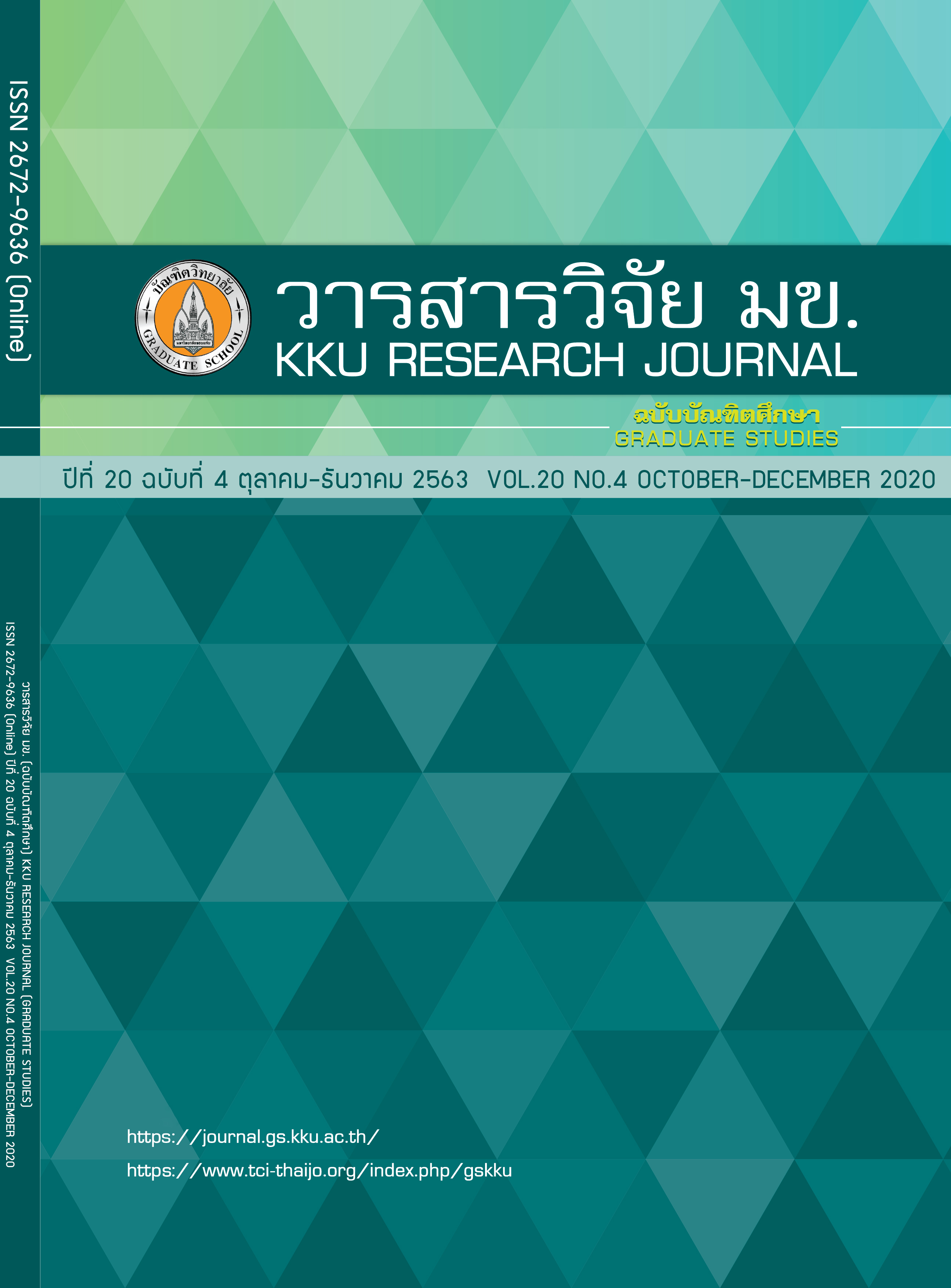Food per Microorganism (F/M ratio) to Pig Manure Wastewater Biogas Production at Suranaree University of Technology Farm
Keywords:
Biogas, Pig manure wastewater, Food per MicroorganismAbstract
This study was aimed to determine the optimum Food per Microorganism (F/M ratio) for biogas production from pig manure wastewater. F/M ratio was varied from 0.50 to 2.00 day-1 with 20-days Hydraulic Retention Time in batch test experiment. Statistical analysis of One-way ANOVA at the 95.0% confidence level revealed that biogas volume was significantly not different (a > 0.05). The result suggested that the F/M Ratio 0.50 day-1 Organic Loading Rate 11.7 kg.COD/m3-day at carbon-to-nitrogen ratio (C/N ratio) 16.3 and C : N : P at 100 : 6.10 : 0.63 could produce optimum biogas volume of 4.33 m3/kg.COD from pig manure wastewater with the efficiency Chemical Oxygen Demand removal (79.2%).
References
Chantamas N. Effect of velocity gradient and organic loading rate on wastewater treatment from palm oil mill using ASBR system. Master of Science in Environmental Science, Chulalongkorn University. 2009. Thai.
Srinuch W. Nutrients digestion and changes in the rumen production of dairy cows receiving mixed food containing sweet corn stew, marinated as a rough food source. Maejo University, Chiang Mai. 2009. Thai.
Department of Alternative Energy Development and Efficiency, Biogas production from Waste of livestock and industrial plants, source : http://www2.dede.go.th/km_ber/Attach/Biogaspresent.pdf, August 22th, 2010. Thai.
Tangtaveewat S. Biogas production from dung and food waste For household use, source : www.clinictech.most.go.th/online/techlist/attachFile/20111261832311.pdf. 2004.
Kafle GK, Kim SK, Shin BS. Anaerobic Digestion Treatment for the Mixture of Chinese Cabbage Waste Juice and Swine Manure. Journal of Biosystems Engineering, 37(1) : 58 - 64. 2011.
Kafle GK, Chen L. Comparison on batch anaerobic digestion of five different livestock manures and prediction of biochemical methane potential (BMP)using different statistical models. Waste Management, 48:492-502. 2016.
Nazrul IM, Park KJ, Yoon HS. Methane Production Potential of Food Waste and Food Waste Mixture with Swine Manure in Anaerobic Digestion. Journal of Biosystems Engineering, 37(2) : 100 -105. 2012.
Kafle GK, Kim SH. Anaerobic treatment of apple waste with swine manure for biogas poduction: Batch and continuous operation. Applied Energy, 103 : 61 – 72. 2013.
Kafle GK, Kim SH. Kinetic Study of the Anaerobic Digestion of Swine Manure at Mesophilic Temperature: A Lab Scale Batch Operation. Journal of Biosystems Engineering, 37(4) : 233 - 244. 2013.
Pantuwongrat T. Effects of organic loading rates on performance of EGSB system treating piggery wastewater. Master's thesis of Engineering Environmental Engineering Chiang Mai University. (In Thai). 2005.
Siddique NI, Munaim SA, Zularisam AW. Effect of food to microbe ratio variation on anaerobic co-digestion of petrochemical wastewater with manure. Journal of the Taiwan Institute of Chemical Engineering, 58 : 451 – 457. 2016.
Miao H, Wang S, Zhao M, Huang Z, Ren H, Yan Q, Ruan W. Codigestion of Taihu blue algae with swine manure for biogas production. Energy Conversion and Management, 77 : 643 – 649. 2013.
Chaiprasert P, Hudayah N, Auphimai C. Efficacies of Various Anaerobic Starter Seeds for Biogas Production from Different Types of Wastewater. Biomed. Res. Int, (1) : 1 – 13. 2016.
APHA, AWWA, WPCF, Eaton AD, Franson M, Ann H. Standard methods for the examination of water and wastewater, 20th ed.Washington DC : USA. 2005.
Department of Alternative Energy Development and Efficiency, Study and demonstrate the production of biogas from biomass, source : http://webkc.dede.go.th/testmax/node/197.
Racho P. Study process anaerobic treatment system and biogas production, Environmental Laboratory. School of Environmental, Institute Engineering, Suranaree University of Technology. (In Thai). 2018.
Wannakomol A. Biogas production from shrimp farming wastes. Research at Suranaree University of Technology. (In Thai). 2014



